Ijraset Journal For Research in Applied Science and Engineering Technology
- Home / Ijraset
- On This Page
- Introduction
- Conclusion
- References
- Copyright
Herbal Drugs Used in the Treatment of Diabetes Mellitus
Authors: Komal Landge, Dr. Hingane L. D.
DOI Link: https://doi.org/10.22214/ijraset.2022.45027
Certificate: View Certificate
Abstract
Introduction
I. INTRODUCTION
Diabetes is a chronic metabolic disorder of proteins, fats and carbohydrate, affecting a large number of world population in the world Diabetes mellitus is known as a group of chronic metabolic diseases characterized by rise in blood glucose level due to defects in insulin secretion, insulin action, or both. The chronic hyperglycemia in diabetes is associated with long-term damage, dysfunction and failure of various organs especially the heart, eyes, blood vessels, kidneys, and nerves 2. Various pathological changes are responsible for development of diabetes. Autoimmune destruction of the β-cells of the pancreas causes decrease in insulin secretion and lead to insulin deficiency. The basis of the abnormalities in metabinsulin on target tissues known as insulin resistance. Deficient insulin action results from inadequate insulin secretion and/or diminished tissue responses to insulin at one or more points in the complex pathways of hormone action. Hyperglycemia occurs in patients due to defects in insulin action frequently coexist in the same patient. Impairment of insulin secretion and hyperglycemia characterized by symptom such as polyuria, polydipsia, weight loss, sometimes with polyphagia, and blurred vision. olism of carbohydrate, fat, and protein in diabetes decreases Impairment of growth and susceptibility to certain infections may also be associated with chronic hyperglycemia. Uncontrolled diabetes characterized with hyperglycemia with ketoacidosis or the nonketotic hyperosmolar syndrome is an acute life-threatening consequence.
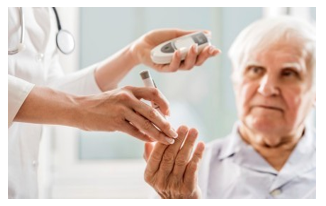
Long-term complications of diabetes include nephropathy, neuropathy, retinopathy, amputations, foot ulcers, Charcot joints, autonomic neuropathy causing genitourinary, gastrointestinal, and cardiovascular symptoms and sexual dysfunction. Impairment of insulin secretion and hyperglycemia characterized by symptom such as polyuria, polydipsia, weight loss, sometimes with polyphagia, and blurred vision. olism of carbohydrate, fat, and protein in diabetes decreases Impairment of growth and susceptibility to certain infections may also be associated with chronic hyperglycemia. Uncontrolled diabetes characterized with hyperglycemia with ketoacidosis or the nonketotic hyperosmolar syndrome is an acute life-threatening consequence. Long-term complications of diabetes include nephropathy, neuropathy, retinopathy, amputations, foot ulcers, Charcot joints, autonomic neuropathy causing genitourinary, gastrointestinal, and cardiovascular symptoms and sexual dysfunction. Diabetic subject have an increased incidence of peripheral arterial, atherosclerotic cardiovascular and cerebrovascular disease. Abnormalities of lipoprotein metabolism and hypertension are often found in diabetics. In past few years, field of herbal medicines are growing exponentially and these drugs are gaining popularity both in world because of it is derived from natural origin and having minimum side effects. Many traditional medicines in use are derived from medicinal plants, minerals and organic matter.
A 60% of world population is using traditional medicines which are derived from medicinal plants. This review basically focused on Indian herbal drugs and plants used in the treatment of diabetes, especially in India. Diabetes is an important human ailment afflicting many from various walks of life in different countries. In India it is proving to be a major health problem, especially in the urban areas. Though there are various approaches to reduce the ill effects of diabetes and its secondary complications, herbal formulations are preferred due to lesser side effects and low cost Many of allopathic medicines are available for the treatment of diabetes but somehow they have their own side effect & adverse effect like hypoglycaemia, nausea, vomiting, hyponatremia, flatulence, diarrhoea or constipation, alcohol flush, headache, weight gain, lactic acidosis, pernicious anaemia, dyspepsia, dizziness, joint pain. So instead of allopathic drugs, herbal drugs are a great choice which is having more or less no side effect & adverse effects.
A. Epidemiology of Diabetes Mellitus
The prevalence of diabetes and pre-diabetes are increasingly high in developing countries, where many of diabetic and pre-diabetic subjects are remained to identify. People with Pre-diabetes often have the chance to reverse both the condition and their chances of going on to develop diabetes by up to 60 % simply through losing even just a moderate amount of weight, adopting a healthy balanced diet and increasing physical activity levels. According to world health organization (WHO) estimates, in 2005 approximately 1.6 billion adult were overweight and at least 400 million were obese worldwide, number that projected to reach 2.3 billion and 700 million, respectively, by 2015. Paralleling these trends, in 2010 about 300 million people were estimated to have DM globally and this number expected to increase to near about 450 million by 2030 .
B. Types of Diabetes Mellitus
- Type 1 Diabetes: Type 1 diabetes, previously called insulin-dependent diabetes mellitus (IDDM) or juvenile onset diabetes, may account for five percent to ten percent of all diagnosed cases of diabetes. Risk factors are less well defined for Type 1 diabetes than for Type 2 diabetes, but autoimmune, genetic, and environmental factors are involved in the development of this type of diabetes.
- Type 2 Diabetes: Type 2 diabetes was previously called non-insulin-dependent diabetes mellitus (NIDDM) or adult-onset diabetes, which are mainly due to insulin resistance or abnormality in insulin secretion. Type 2 diabetes may account for about 76 - 85 % of all diagnosed cases of diabetes Risk factors for Type 2 diabetes include older age, obesity, and family history of diabetes, prior history of gestational diabetes, impaired glucose tolerance, physical inactivity, and race/ethnicity.
C. Introduction of Herbal Medicine How do herbal medicines work?
All herbal plants having specific active constitutes that gives a therapeutic action. Medicinal plants containing many active chemical constitute, and it is likely that they work together to produce the desired synergetic medicinal effect. The type of environment (climate, bugs, soil quality) in which a plant grew will affect its active components, as will how and when it was harvested and processed that also important for action of herbal medicine
D. How are herbal medicines used?
Herbal medicine is the study of the botony and use of Medicinal plant. Plant have been the basis for medicinal treatment through much of Human History is called as Herbal Medicine These active chemical constituents are working together to produce therapeutic effects and also decreases the chances of side effects from any one component. Numbers of herbs are often used together to enhance effectiveness and which is responsible for synergistic actions and to reduce toxicity. Herbalists must take many things into account when prescribing herbs. For example, the genus or species and diversity of the plant, the plant's habitat, how it was stored and process.
E. Herbal Medicine since Ancient Time
In ancient literature more than 800 plant species have been reported to have potent antidiabetic activity 20. The ancient or Ayurvedic literature survey is demonstrating that the in India diabetes was practically well known and well-conceived since ancient time. The knowledge of the system of diabetes mellitus, as the history reveals, existed with the Indians since prehistoric age 21, 22. Ayurvedic antidiabetic medicinal plant increases Rasas (gastric secretions) and improves digestive power, being Laghu, being Ruksha and gets easily digested in the body decrease . Food substances, which are ‘madhumehaghna’ (antidote), are an important essential principle of therapy for the prameha (diabetes) patient.
Classification of Antidiabetic Agent: Oral Hypoglycemic agent
- Drug acting by the release of insuline
- Drug acting by other Mechanism
- Biguanides :-E.g Metforming and Phenforming
- Thiazolidinediones :-E.g Adiponectine
- Alpha-Glucosidase inihibators
- Exenatide and liraglutide
- Dpp-4 Inihibators
- Amylin Derivativess
- D2 Agonist
II. HERBAL DRUG THAT ARE USED IN THE TREATMENT OF DIABETES MELLITUS
A. Onion
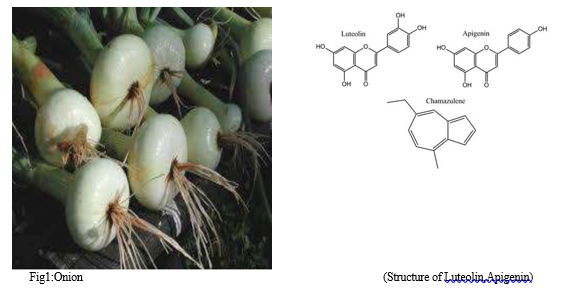
- Allium cepa: Pyaj (Hindi) and Onion )
- Biological source: It is the most widely cultivated species of genus Allinum
- Family: Amaryllidaceae
- Mechanism of action: It is cultivated showed most potent hypoglycemic action . Petroleum ether insoluble fraction of the ether extract of dried onion powder (100 mg/ kg) given orally for 7 days to alloxanized (180mg/kg) throughout India and is an important dietary constituent. Various ether soluble fractions of onion as a single oral dose(0.25 mg/kg) showed significant hypoglycemic effect in normal fasted rabbits. Ethyl ether extract diabetic rabbits caused a significantanti-hyperglycemic effect . reductase. The effect was comparable to that of glibenclamide and insulin Also showed beneficial effect of SMCS and Sallylcysteisulfoxide (SACS) inalloxanized diabetic rats on glucose intolerance, weight loss and liver glycogen also decreased hyperglycemic peak in subcutaneous glucose tolerance in rabbits.
- Pharmacokinetic: It is absorb in oral route.it is distributed to bodytissue and then metabolised in liver and elemanated through kidney by urine and swetting
- Dose: 250mg [bis in die]
- Side Effect: Nausia, vomitting, Diarrea
- Uses:- Anti-inflametry, Use in the treatment of Diabetes mellitus
B. Garlic
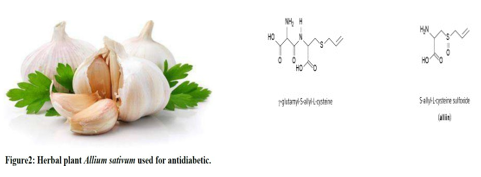
- Allium Sativum: (garlic)Bio source:-It consist of dried Roots of Allium Sativum
- Family liliaceae. This is a perennial herb cultivated throughout India. Allicin,
- Mechanism action: sulfur-containing compound is responsible for its pungent odour and it has been shown tohave significant hypoglycemic activity.[10] This effect is thought to be due to increasedhepatic metabolism, increased insulin release from pancreatic beta cells and/ or insulin sparing effect. Aqueous homogenate of garlic (10ml/kg/day) administered orally to sucrose ferabbits (10g/kg/day in water for two months) significantly increased hepatic glycogen and free amino acid content, decreased fasting blood glucose, and triglyceride levels in serum incomparison to sucrose controls.
- Pharmacokinetics: It is absorb in orally and distributed through to body tissue and then Metabolised in LIver and Elemanation through kidney by liver
- Dose:10 gm/Day
- Side effect: Heartburn, unplesent breath or body odor, diarrhea
- Use: Atherosclerosis, coronory artery disease, hypertention, antidiabetics
C. Neem
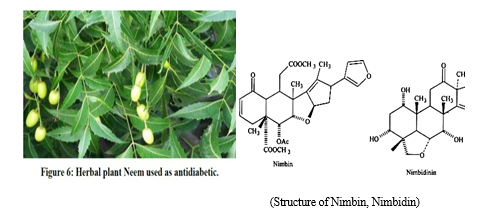
- Neem (Hindi) Bio.source:-It consist of dried leaves of plant Azadirachta indica Family: Meliaceae. Whole plants parts are used. Nimbidin is major sourcefrom seed oil, It is crude bitter principle. It also contain nimbin, nimbinin, nimbidinin, nimbolide, nimbilic acid. Gedunin obtained from neem’s seed. It also contain mahmoodin, Azadirachtin. It also contains some tannin like, Gallic acid. There are also present of Margolonon, Polysaccharide.
[15] Hydroalcoholic extracts of this plant showed antihyperglycemic
- Mechanism of Action: activity in streptozotocin treated rats and this effect is because of increase inglucose uptake and glycogen deposition in isolated rat hemidiaphragm. Apart from havinganti-diabetic activity, this plant also has anti-bacterial, antimalarial, antifertility,hepatoprotective and antioxidant effects.
- Pharmacokinetic: It is absorb in oral route and Distributed to body tissue, and then Metabolism in Liver and Elimanation throgh kidney by urine
- Dose:500mg [bis in die]
- Side effects: diarrea ,,drowsiness, coma, brain disorder
- Use: stomach ulcer, heart disease, malaria, indigestion, diabetes
D. Mango
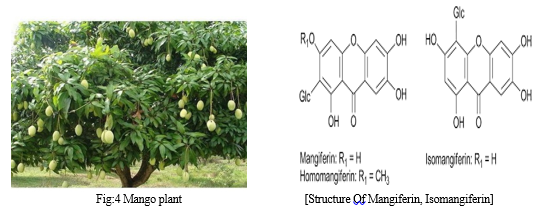
- Mangifera indica L: Mango The aqueous extract produces reduction of blood glucose level in norm glycemic and glucose-induced hyperglycemia, but does not have
- Mechanism of Action: any effect on streptozotocin-induced diabetic mice under the same conditions when compared with that of an oral dose ofchlorpropamide. The result indicates that the aqueous extract of the leaves of M. indica possess hypoglycemic activity
- Pharmacokinetic: It is absorbed in orally and widley Distributed through to body tissue and then Metabosim in Liver and Elemanated through Urine
- Dose:150 mg/Day
- Side Effect: loose motion, diarrea, vomiting
- Use: fights restlessness, healsburns, mango leaves are use in diabetes mellitus
E. Guduchi
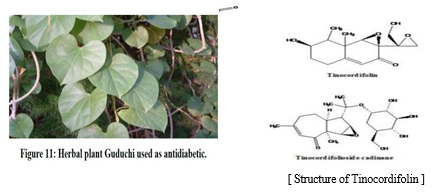
- Tinospora cordifolia: (Guduchi)
- Bio.Source:- It is a large, glabrous, deciduous climbing shrub Tinospora cordifolia belonging to the
- Family:- Menispermaceae.
- Mechanism of Action: is widely distributed throughout India and commonly known as Guduchi. Oral administration of the extract of Tinospora cordifolia roots for 6 weeks resulted in a significant reduction in blood and urine glucose and in lipids in serum and tissues in alloxan diabetic rats. The extractalso prevented a decrease in body weight. T. cordifolia is widely used in Indian ayurved medicine for treating diabetes mellitus.
- Pharmacokinetic: It is absorb in oral route and Distributed through body tissue and Metablised in Liver and Elemanation through kidney by Urine
- Dose: 3-6 gm/Day,25-50 ml/Day
- Side effect: Anoroxia, Nausia, Vomitting, Hypertotoxicity
- Use: chronic fever, rheumatic disorder, diabetes disorder, renal aliments
F. Fenugreek
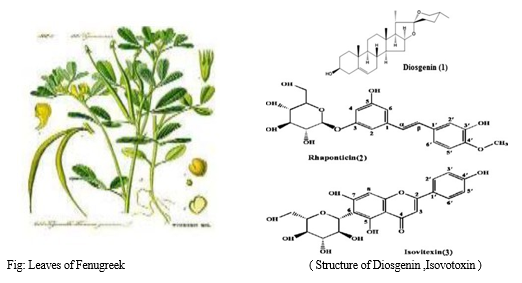
- Trigonella graecum: fenugreek
- Bio.Sourece:-It conist of dried leaves of plant Trigonella Foenum graecum species
- Family:- Fabaceae constituents of Indian spices. 4-hydroxyleucine, a novel amino acid from fenugreek seeds.
- Mechanism of Action: Increased glucose stimulated insulin release by isolated islet cells in both rats and humans. Oral administration of 2 and 8 g/kg of plant extract produced dose dependent decrease in the blood glucose levels in both normal as well as diabetic rats. Administration of fenugreek seeds also improved glucose metabolism and normalized creatinine kinase activity in heart,skeletal muscle and liver of diabetic rats. It also reduced hepatic and renal glucose-phosphatase and fructose –1, 6- biphosphatase activity. This plant also shows antioxidant activity.
- Pharmacokinetic: It is absorb in oral route and widley Distribution through body tissue and Metabolism in Liver and then Elemanation through kidney by Urine
- Dose: 450/Day
- Side Effects: high colesterol, male infertility, weight loss, parkinosim disease, diabetes disease
- Use: Fenugreek use for diabetes, painful menstruction, monopause
G. Turmeric
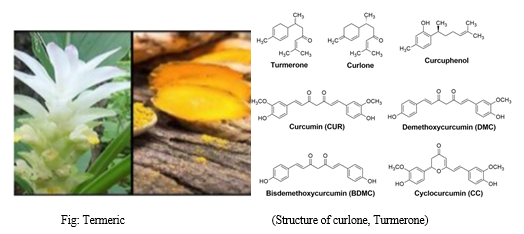
- Haldi (Hindi) and Turmeric (English)
- Bio-Source:-It consist of dried roots of Curcuma longa
- Family: Zingiberaceae. The effect of Aqueous Extract of Curcuma longa (AEC) on insulin secretion in pancreatic tissues with acute incubations under hyperglycaemic conditions and also chronic incubations under both basal and hyperglycaemic conditionswere examined in vitro. Under hyper glycaemic culture conditions all the doses of AEC .
- Mechanism of Action: 30 min of incubation showed an inhibited insulin release which was significantly different from the control (p < 0.05). No significant difference was observed between the 0.1, 1 and 10mL doses of AEC (p > 0.05), but the highest dose of AEC (100 mL) was significantly different from the control and the other doses ofAEC (p < 0.05). Tolbutamide, on the otherhand, significantly stimulated insulin secretion.
- Pharmacokinetic: The absorbtion of Termeric is orally and parentrally and Distributed through body tissue and then Metabolism in Liver and Elemanation through kidney by Urine, swetting
- Dose:1500 mg twice day
- Side effect :Stomach Upset, Nausea ,Omitting,Diarrhea
- Use: Pain-full Inflammation, Fever, Depression, Liver Disease, Itching
H. Liquorice
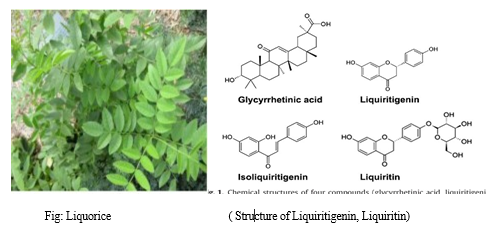
- Bio source:- Liquorice is the root of Glycyrrhiza glabra as well as a herbaceous perennial legume.
- Family :-Fabaceae liquorice root is an ancient traditional herbal remedy for tackling several ailments. Scientists Sreveal that liquorice root from the papilionaceae family may be effective for treating type 2 diabetes which is more common with overweight or obese individuals thus leading to insulin
- Mechanism of Action: Resistance. Liquorice roots contain anti-diabetic substances known as amorfrutins, which are capable of reducing the blood sugar levels as well as preventing inflammation associated with diabetics. The name amorfrutins was derived from the Amorpha fruticosa, which is aflowering plant belonging to the leguminous family.
- Pharmacokinetic: It is absorb in oral route and Distribution to body tissue and then Metabolism in Liver and Elemanation through kidney by Urine
- Dose:750 mg,15 gm
- Side effect: Headache, CHF, Erectile dysfunction, Hpertention, Use in diabetes
- Use: Sore Throat, cough, stomach ulcer, heartburn, use in diabetes
I. Vinca
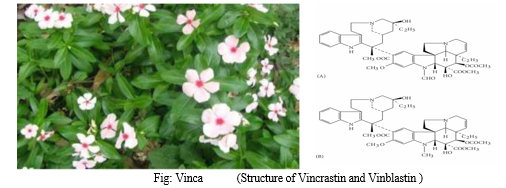
- Bio Source :-It consist of flowering plant leaf extract of Catharanthus roseus
- Family:- Apocynaceae
- Mechanism of Action: All induced diabetic rats. The levels of blood glucose were significantly decreased when compared with Control rat. The blood glucose lowering effect of C. roseus methanolic extract was more pronounced than Glibenclamide and Metformin.
- Pharmacokinetic: It is absorb in oral route and Distrubation through body tissue and Metabolism in Liver and then Excretion through kidney by Urine
- Dose: 100mg/Day
- Side effect: Vomiting, Hair Loss, Dizziness, Bleeding, Liver Damage
- Use: It is use in breast cancer ,Hodgkin disease and diabetes disease
J. Bitter Guard

- Momordica charantia: Karela (Hindi) and Bitter Gourd (English)
- Family: Cucurbitaceae.
- Mechanism of action: Studied the mechanism of actionof juice in rats. Rats were rendered diabetic by single injection (60 mg/kg body weight)of streptozocin. One week after injection, treated animals were fed with juice ofM.charantia (10 ml/kg) daily for three inglucose uptake and attenuated the insulininduced increase in glucose uptake induced increase in glucose uptake.
- Pharmacokinetic: It is absorb in orally and Distribution through body tissue and then Metabolism in Liver and Elemanation through kidney by Urine
- Side effect: Nausia, Diarrea, Vomitting, Dizziness
- Dose: 100/Day
- Use: Liver disease, Psoriasis, HIV and Diabetes Disease
K. Aloe
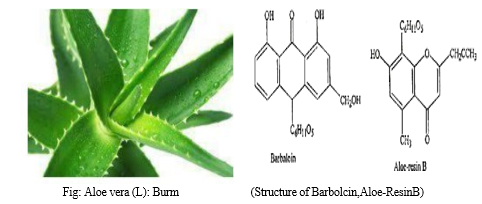
- Bio Source :-It consist of dried leaves of Plant aloe barbedensis
- Family :-Liliaceae Aloe vera grows in arid climates and is widely distributed in Africa, India and other arid
- Mechanism of action: Aloe Vera gel at 200 mg/kg possesses significant antidiabetic, cardioprotective activity, reduces the increased TBARS, maintains the Superoxide dismutase and Catalase activity up to the normal level and increases reduced glutathione by four times in diabetic rats.
- Pharmacokinetic: It absorb in orally and Distribution through body tissue and then Metabolism in Liver and Elemanation through kidney by Urine
- Dose:200mg/Day
- Side effect: Hypoglycemia, burning, stomach pain ,liver problem
- Use: Reduce Dental Plague, Antioxidant, Reduce Constipion,
L. Bael
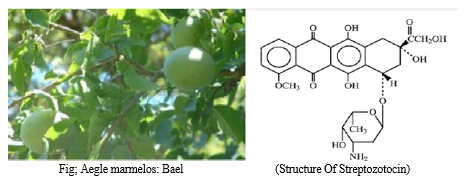
- Bio Source ;- It consist of the unripe froots of Aegle Marmelos
- Family :-Rutaceae Aqueous leaf extract of Aegle marmelos showed antihyperglycemic activity in streptozotocin
- Mechanism of action: Induced diabetic rats after 14 days treatment either by increasing utilization of glucose or by direct stimulation of glucose uptake through increased insulin secretion.
- Phamacokinetic: It absorb in oral route and Distribution through body tissue and Metabolism in Liver and Elemanation through kidney by Urine
- Side effect: Constipation ,Depression, Diarrhea, Stomach ache
- Dose:100 mg
- Use: Use in Diabetes ,Asthma, Memory Problem
M. Ocimum Sanctum
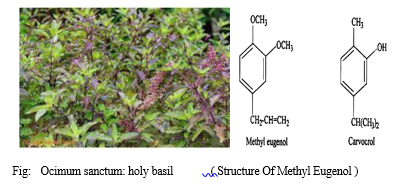
- Bio Source:- It consist of dried leaves of ocimum sanctum
- Family:- Labatae is commonly known as Tulsi. Since ancient times, this plant is known for its medicinal properties. The aqueous extract of leaves of Ocimum sanctum showed the significant reduction in blood sugar level in both normal and alloxan induced diabetic rats.
- Mechanism of action: Reduction in fasting blood glucose, uronic acid, total amino acid, total cholesterol, triglyceride and total lipid indicated the hypoglycemic and hypolipidemic effects of tulsi in diabetic rats. Oral administration of plant extract (200 mg/kg) for 30 days led to decrease in the plasma glucose level by approximately 9.06 and 26.4% on 15 and 30 days of the experiment
- Pharmacokinetic:It is absorb in Orally and Distribution through whole body tissue and Metabolism in Liver and Elimantion through Kidney by Urine
- Dose: 300 mg/day
- Side effect: Nausea, Vomiting, Dizziness, Retching, Hypoglycemia
- Use: Asthma, Skin Disorder, Colds, Congestion, Cough, Flu
II. CURRENT AND FUTURE TREND IN HERBAL MEDICINE:
Herbal medicine is an important component towords alternative medicine .it is a become more popular in today world because of natural remidies .herbal medicine based traditional medical system of treatment is a rapidly growing helthcare syste of economic importance and is now widely used in many countries of the world. in africa upto 80% of population uses this herbal traditional medicine system to meet their healthcare needs. in asia and latine america,people continoue use to this system as results of histrical circumstances and cultural beliefs. In china ,Tm accounts for 40% of all health cares delivered.
In future ,increasing use and fast growing market of herbal medicine and other healthcare products in both developing and developed countries of the world ,policy makers health professionals and public are incresingly expressing concern about the safety .
Efficacy ,quality ,availibility , preservation and future development problem of this herbal product and TM/CAM practice s.In order to allay these concern and to meet public demands ,It provide and aimed to explain diffrent kinds of herbal medicine.
Conclusion
Herbal plants are playing a significant role in the treatment of various diseases. Plants have been traditionally used for their various purposes. They exhibit more reliable criterias fortheir usage as the natural source of medicaments which are free from side effects and pertain longer shelf life. Due to these features, plant drugs are being used on larger scale nowadays for the treatment of Diabetes. They are available in the form of poly herbal formulations which are very effective in the control of Diabetes.
References
[1] Shukla A, Shukla HM. A review on antidiabetic herbal drugs. JDD2012; 3(4):31-35 [2] WHO Expert Committee: Diabetes Mellitus. 2nd rep. Geneva, World Health Org.,Tech. Rep., 1980; Ser. 646. [3] Dwivedi C, Daspaul S. Areview on Antidiabetic Herbal Drugs and polyherbalformulation used for diabetes. JOCPR, 2010 4(2): 90-97. 4. Rao. M. Upendra, M. Sreenivasulu, et al, Herbal Medicines for Diabetes Mellitus: A Review, International Journal of Pharm Tech Research, 20102(3): 1883-1892, [4] Ramachandran A., Snehalatha C., Viswanathan V. Burden of type 2 diabetes andits complications- the Indian scenario. Curr. Sci., 2002; 83: 1471–14766. Bordoloi R, Dutta KN, A review on herbs used in the treatment of Diabetes mellitus,JOCPR, 2011; 2(7): 34- 40. [5] Liu IM, Tzeng TF, Liou SS and Lan TW. Improvement of insulin sensitivity inobese Zucker rats by myricetin extracted from Abelmoschus moschatus. Planta Medica, 2007; 73: 1054- 1060. [6] Patel P, Harde P, Pillai P, Darji N, Patel B. An International Research Journal Antidiabetic Herbal Drugs A Review Available Online At Review Article Pharmacophore, 2012; 3: 18- 29. [7] Mathew PT, Augusti KT. Hypoglycemic effects of onion, Allium cepa Linn, on diabetes mellitus- apreliminary report. Indian Journal of Physiology and Pharmacology, 1975; 19: 213-217. [8] Modak M, Dixit P, Londhe P, Ghaskadbi S, Paul T. A. Indian Herbs and HerbalDrugs Used for the Treatment of Diabetes., J. Clin. Biochem. Nutr, 2007; 40:163–173.
Copyright
Copyright © 2022 Komal Landge, Dr. Hingane L. D.. This is an open access article distributed under the Creative Commons Attribution License, which permits unrestricted use, distribution, and reproduction in any medium, provided the original work is properly cited.

Download Paper
Paper Id : IJRASET45027
Publish Date : 2022-06-28
ISSN : 2321-9653
Publisher Name : IJRASET
DOI Link : Click Here
 Submit Paper Online
Submit Paper Online

